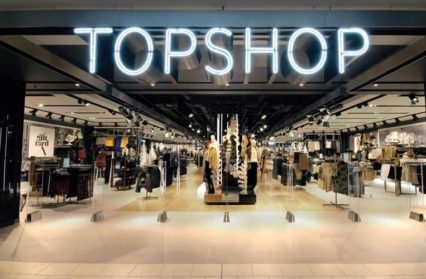Sir Philip Green’s Arcadia Group has finally fallen into administration, so is this the end for fashion-industry giant Topshop? Esyllt Sears reminisces on her experiences with fashion as a youngster and divulges her partiality to the Topshop era and brand itself.

It’s happening. Arcadia Group’s businesses are, one by one, going into the hands of the administrator. I’ve already seen some commentators placing the blame firmly at the pandemic’s feet but it’s been a long, hard, drawn-out slog to the bottom for Philip Green’s empire.
It’s hard to sympathise with a man who probably loses more sleep over rudder rust than his staff’s pension funds but, if Topshop doesn’t survive this retail massacre, I will allow myself a full three days of mourning.
No, I won’t lose my job. No, I don’t have shares in the company. I don’t even have a pile of their clothes I may or may not want to return and/or exchange in the next month. I just cannot understate what a huge impact Topshop had, not merely on the high street but on myself and other women my age.
I won’t give you an X-Factor style sob story but… I grew up in the fashion wasteland that was the 80s and 90s Aberystwyth. Peacocks were the largest women’s clothes shop, one independent store had all the crushed velvet smocks and sequined hats your heart desired (and my heart desired), and we bought our Dr Martens at the budget hardware store and they were CHEAP. How do I know? Because it was the one trend my mum didn’t mind us latching onto.
Several girls and their mothers would travel to Shrewsbury or Telford to buy fashion. I was lucky that my grandparents lived in the Rhondda which gave me access to the Valley Lines and a direct train into Cardiff every school holiday. On Boxing Day, while everyone on Queen Street was making a b-line for the sales I submerged myself in Topshop’s new season offerings.
Clothes are important. I remember clothes. I can recall what I was wearing when I had my first ever kiss (and we’re back to the crushed velvet and Dr Martens); what I wore when I met my now-husband; what I had on, or didn’t have on at both my kids’ births; and what I was wearing when I was called in to see HR in the noughties on account of my inappropriate dress (the heels were too high and the dress much too short but I was a 26-year-old doing military fitness training four times a week and I looked fit AF). And the one thing all those outfits had in common? They included at least one Topshop item.
I fully immersed myself in the Topshop brand when I moved to Cardiff to attend university; my student loan burning a hole in my pocket. A few years later I moved to London to work and, as much as I would like to tell you that I trawled flea markets and charity shops for priceless and unique items, Topshop’s flagship store on Oxford Street became my second home. My first expensive item of clothing, that wasn’t a coat, was a skirt from their independent designer showcase rack – a long dark turquoise skirt with thin black lines, purple zebra outlines and a massive big pink ribbon on the back which I wore to a friend’s work event. I felt so grown-up and fancy. I still have it.
You’d see their clothes featured in both reasonably priced magazines and higher-end glossies. The clothes felt catwalk-relevant (not least because of the Kate Moss-endorsed campaigns they ran), and they were affordable without being disgracefully cheap. My love for Topshop and what it meant to me as a young woman trying to figure out her style, is eternal. Heck, my dad even mentioned my Topshop jack-in-the-box of a suitcase that I would always leave in my parents’ hallway on visits home, in his speech at my wedding.
As other retailers worked to make fashion more accessible, Topshop became more expensive and on top of this, it has never been very accommodating of larger dress sizes. And remember, we’re no longer in 90s heroin chic territory. Young girls today have so many amazing plus size influences and are encouraged more than ever to embrace their individual, unique bodies.
From what I can see, H&M seems to have the Topshop era – or what I remember of the brand in my early 20s. Reasonable but decent quality fashion and they sell an increasing number of sustainable items which you just HAVE to do these days if you’re building a strong, sustainable brand.
Now, back to Aberystwyth. I have a vague memory of a Topshop franchise in the town. This was when I was too young to have an opinion about what I wore, let alone buy my own things. I seem to remember it shut in the early 90s when I was a pre-teen. Imagine. We just weren’t ready for it. And now? I’m not sure I’m ready to say goodbye.
I don’t know if it can be saved. I don’t know if it even should be saved. But if the appetite’s there, it should be much less about the big splash campaigns and more about accessible, catwalk-worthy, ethical fashion.
If it manages it, I’ll see you on Queen Street, 26th December when restrictions allow.
This piece on the Topshop era is by Esyllt Sears, a writer and stand-up comedian from Aberystwyth.
Topshop clothes are now available to purchase online through ASOS.










